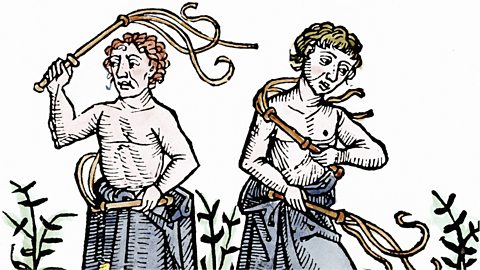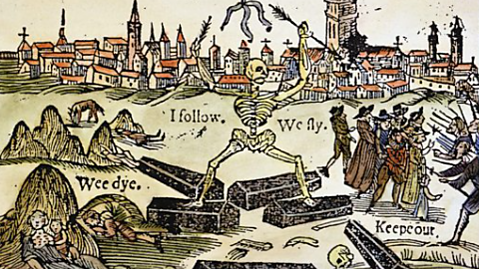Key points
- In 1348 - 49, the Black Death swept across Europe, killing up to half of the population.
- There were two main types of plague: bubonic and pneumonic.
- Treatments and cures were based on both natural and supernatural theories about the cause of the disease.
Video about the Black Death
Narrator:
I've been caring for patients of this horrible plague these last few months. Many other doctors have fled the city for fear of catching the disease, but it seems it is everywhere. A French doctor, Guy de Chauliac, has identified two types of the disease. Bubonic, which makes the glands in the neck, armpits and groin swell and ooze pus and blood. It usually kills the patient within five days.
Pneumonic, which infects the lungs, making people cough up blood. This usually kills within three days. The disease is so contagious that people think you can catch it just by looking at someone who is afflicted. People are scared and look to religion or other explanations for its causes. Some say it's a punishment from God. Some say it is caused by planetary movement.
Some say the wells are being poisoned. People have been trying lots of different things to try and cure themselves of this terrible disease. People rub themselves with onions and herbs. I even saw a young man rubbing himself with a dead pigeon he had cut up. They sometimes drink poisons or vinegars to try and kill the illness. They sit near fires trying to sweat the disease out. I truly hope that some of the people I've been trying to help will soon recover.
I think that clean air, a healthy diet and letting blood flow from the patient will help. I pray to God every night that we will soon find out what causes this deadly disease.
How did the Black Death get its name?
The term 'Black Death' was first used in English in the 1700s. At the time of the epidemic, most people would have called the disease 'the pestilence' or 'the Great Mortality'.
The term 'Black Death' specifically refers to the outbreak of the plague disease in the mid-1300s. Later outbreaks, like the one in London in 1665, have been referred to as 'the Plague'.
The Black Death arrives in England
The Black Death originated in Asia in 1346. It was spread to Europe by fleas on rats living on trade ships. In medieval times there was trade between Europe and Asia. The Crusades increased awareness of goods and produce that could be imported from abroad. This trade helped bubonic plague to spread from Asia to European countries.
Bubonic plague is believed to have arrived in the country on a ship landing on the Dorset coast from Gascony in France. The disease quickly spread throughout the country. The first recorded case of the Black Death in England was in June 1348.
It is now widely accepted that plague was caused by the Yersinia pestis bacteriaThe bacteria that was responsible for plague, which was often transferred from rats to people by fleas., although this wasn’t understood at the time.
Types of plague
Bubonic plague
Bubonic plague was spread by rats, which were commonly found in homes, villages and towns due to poor hygiene conditions such as raw sewage being routinely dumped in streets. If a flea that had bitten an infected rat jumped onto a person and bit them, it would transmit bubonic plague.
Bubonic plague had a mortality rateThe percentage of people who would normally die from a disease. So a disease with a mortality rate of 50% would mean an average of 50 people would die out of every 100 infected. of approximately 50%.
The symptoms of bubonic plague were:
- Swellings under the armpits and on the groin, known as buboes
- Fever
- Vomiting
- Diarrhoea
- Fingers toes and parts of the skin sometimes turned black
Pneumonic plague
Pneumonic plague was spread from one person to another through coughing or sneezing which spread air droplets containing plague bacteria, affecting the victim's lungs.
Pneumonic plague had a near 100% mortality rate.
The main symptoms of pneumonic plague were:
- Cough
- Fever
- Headaches
- Breathlessness
Ideas about causes and treatments
Natural causes
The discovery that germs cause disease was not made until the 1800s. This meant there was a wide range of beliefs about what might be causing plague. Some of these were based on natural causes, such as miasmaBad air, smells or odours. Many people in medieval times believed it spread disease. caused by the waste and poor sanitary conditions in towns.
Medieval doctors believed that illnesses, including the Black Death, were caused by an imbalance in the four humoursThe four elements that medieval people thought made up the body: blood, phlegm, black bile and yellow bile.. These were black bile, yellow bile, phlegm and blood. A patient diagnosed with excess blood would undergo treatments such as bloodlettingA treatment based on the theory of the four humours. Making a small cut in someone’s arm, a doctor would look to remove excess blood to balance the humours., which attempted to rebalance the humours by removing excess blood.

Supernatural causes
Other ideas were based on religious or supernatural causes. Some people believed God was the cause, as a punishment for people’s sins. flagellantSomeone who whipped themselves to seek forgiveness from God for their sins. would whip themselves to seek forgiveness from God. Others prayed to God for an end to the plague, seeking divine mercy.
astrologistSomeone who believes they can predict the future based on the positions of stars and planets. believed the cause was the alignment of the planets. Others still believed in the ancient idea of trepanning, where doctors would drill a hole in a patient’s head to release bad spirits that were believed to have caused an illness. Some doctors burst the buboes of patients with bubonic plague. There is some evidence that this may have helped increase chances of survival.

Attempts to stop the spread
To try and stop the spread of Black Death, fines were introduced for people caught dumping waste in the streets. The idea was to deal with the bad smells, or miasma. This may have helped a little in that dealing with waste in the streets may have helped limit the number of the rats that were actually spreading the disease.
New jobs were created in London to try and clean up towns. Muckrakers were employed to remove the waste from the streets. latrineA simple type of toilet, usually a hole in a wooden seat emptying directly into a river or pit that would need to be manually emptied. often emptied into pits in the ground. These would often fill up and cause awful smells, so gong farmerSomeone who emptied human waste from cess pits that latrines emptied into. emptied cesspits. Surveyors of the payment collected rubbish.
Consequences of the Black Death
There are various estimates of how many people died during the 1348-49 outbreak. Most historians believe between a third and half of the population were killed by the Black Death. The population of England at the time of the Black Death is estimated to have been around 6 million, so that means approximately 2 to 3 million people died.
Despite the scale of the fatalities, there is evidence that there was some sort of organised response from local government. Mass graves of victims have been found from the Middle Ages. The way the bodies are carefully laid in side by side suggests bodies were treated respectfully and in a dignified way.
A result of the high mortality rateThe percentage of people who would normally die from a disease. So a disease with a mortality rate of 50% would mean an average of 50 people would die out of every 100 infected. was a shortage of workers. This led to rapid wage rises as landowners had to compete for workers by paying more. In 1351 a law was introduced to force wages to go back to the levels they had been at before the Black Death. This was one of the causes of the Peasants’ Revolt in 1381.
As no one knew exactly what caused the Black Death, they could do little to stop future outbreaks. There were further Black Death cases throughout the Middle Ages and beyond. There was another significant outbreak in 1665, particularly affecting London. This outbreak shows there had been no real increase in understanding about what was really causing the disease or how to prevent it.
It wasn’t until the work of Louis Pasteur and Robert Koch in the 1800s that it was discovered germs are the cause of disease. The plague bacteria was finally discovered by Alexandre Yersin in 1894. The bacteria was named after him; ‘Yersinia pestis.’
What do you think the response to the Black Death tells us about medical knowledge in the Middle Ages?
Although doctors in the Middle Ages did not know about germs, there were some attempts to treat or prevent the disease based on observation and natural remedies.
The four humours theory would not correctly diagnose or treat the Black Death, but it was an attempt to treat the disease by understanding how the physical body worked, which is the basis of modern medicine.
The belief that miasma was responsible for the Black Death meant there were efforts to clean up towns by employing gong farmers and muckrakers, which showed that the government was willing to try and address poor public health conditions.
Many people, including doctors, attributed disease to supernatural or religious causes in this period.
Test your knowledge
Play the History Detectives game! gamePlay the History Detectives game!
Analyse and evaluate evidence to uncover some of history’s burning questions in this game.

More on Medicine through time
Find out more by working through a topic
- count2 of 2
